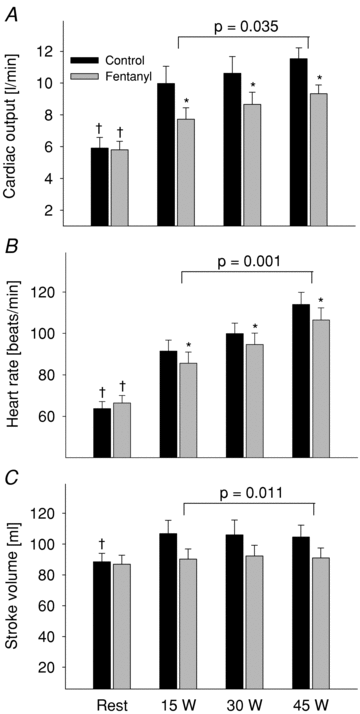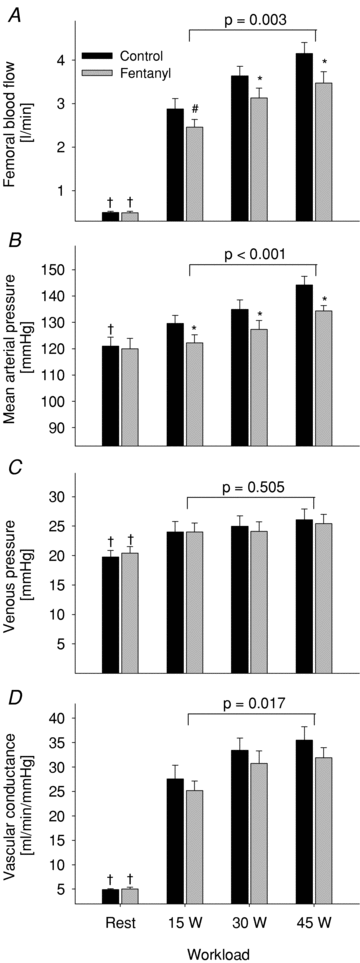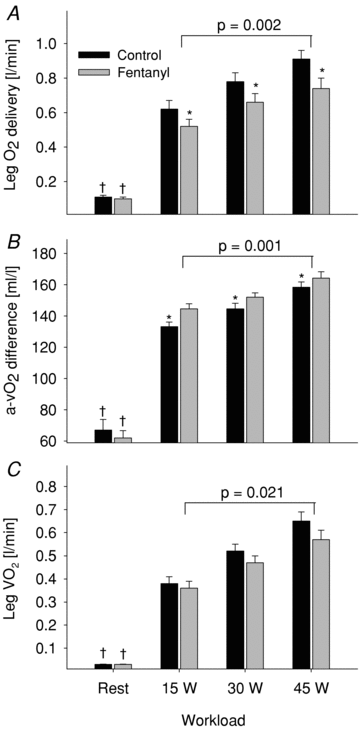On the contribution of group III and IV muscle afferents to the circulatory response to rhythmic exercise in humans
- PMID: 21646407
- PMCID: PMC3171890
- DOI: 10.1113/jphysiol.2011.209353
On the contribution of group III and IV muscle afferents to the circulatory response to rhythmic exercise in humans
Abstract
We investigated the role of skeletal muscle afferent feedback in circulatory control during rhythmic exercise in humans. Nine healthy males performed single leg knee-extensor exercise (15/30/45 watts, 3 min each) under both control conditions (Ctrl) and with lumbar intrathecal fentanyl impairing μ-opioid receptor-sensitive muscle afferents. Cardiac output and femoral blood flow were determined, and femoral arterial/venous blood samples were collected during the final minute of each workload. To rule out cephalad migration of fentanyl to the brainstem,we documented unchanged resting ventilatory responses to different levels of hypercapnia. There were no haemodynamic differences between conditions at rest. However, during exercise cardiac output was -2 % lower with fentanyl blockade compared to control (P < 0.05), secondary to a 6% and 13% reduction in heart rate and stroke volume, respectively. Throughout exercise mean arterial pressure (MAP) was reduced by 7% (P < 0.01) which is likely to have contributed to the 15% fall in femoral blood flow. However, MAP was not completely responsible for this peripheral haemodynamic change as vascular conductance was also attenuated (-9%). Evidence of increasing noradrenaline spillover (P = 0.09) implicated an elevation in sympathetic outflow in this response. The attenuated femoral blood flow during exercise with fentanyl was associated with a 17%reduction in leg O2 delivery (P < 0.01) and a concomitant rise in the arteriovenous O2 difference (4–9%), but leg O2 consumption remained 7–13% lower than control (P < 0.05). Our findings reveal an essential contribution of continuous muscle afferent feedback to ensure the appropriate haemodynamic and ultimately metabolic response to rhythmic exercise in humans
Figures




Comment in
-
Muscle afferent feedback during exercise: putting the pressure on flow.J Physiol. 2011 Dec 15;589(Pt 24):5923-4. doi: 10.1113/jphysiol.2011.220012. J Physiol. 2011. PMID: 22174143 Free PMC article. No abstract available.
References
-
- Amann M, Calbet JA. Convective oxygen transport and fatigue. J Appl Physiol. 2008;104:861–870. - PubMed
Publication types
MeSH terms
Substances
Grants and funding
LinkOut - more resources
Full Text Sources
Other Literature Sources
Medical
Research Materials

